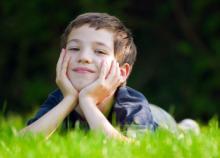
Nature play is child-initiated, unstructured play in “wild” areas, like the vacant lot next door, the neighborhood park, or a wooded area with a stream. Building tree houses, wading in creeks, and catching frogs and butterflies are enjoyable play activities in natural outdoor settings.1
Playing outdoors is one of the things that characterize childhood, giving children the opportunity to explore, discover, practice, wonder, change, create, and learn about the world around them. Children’s basic needs for freedom, adventure, risk-taking, experimentation, and just being children are enhanced by outdoor environments.2 Children can express themselves with more active movement, louder voices, messier activities, and more rough and tumble play in outdoor settings.3
Nature play allows children to fall in love with nature. This inevitably involves learning about nature that is spontaneous and unpredictable, because they want to know more about things they have discovered. Conservationists have learned that when nature play occurs frequently, it is a powerful influence on the development of life-long conservation values.4
There are many benefits for children who regularly play in natural settings. Studies have shown they are more resistant to stress; have lower incidence of behavioral disorders, anxiety, and depression; and have a higher measure of self-worth. Children score higher on tests of concentration and self-discipline. They show more advanced motor fitness, including coordination, balance, and agility. Their play is more diverse with more imaginative and creative play that fosters language and social skills. Children’s cognitive development is improved by increasing their awareness, observational, and reasoning skills.5
It has been discovered that children with Attention Deficit/Hyperactivity Disorder have improved symptoms when playing in green outdoor settings as compared to indoor or non-green outdoor settings. Allowing AD/HD children to play outdoors, especially among natural settings with trees and greenery, can aid their focus on tasks and lessen their impulsive, sometimes aggressive behavior.6
In a study done in 2004, 71% of mothers reported that they played outdoors more than indoors when they were young, while only 26% said their own kids do that today.7 There are many factors that have diminished the amount of outdoor play children have today. Excessive TV viewing, computer use, and video games keep children indoors. Unsafe neighborhoods and busy, overworked parents diminish opportunities for outdoor play. Academic standards raised by No Child Left Behind and the reduction of recess and physical education take time away from outdoor activity.8
Nature-Deficit Disorder (NDD) is a description of the human costs of alienation from nature. Lack of nature play has contributed to childhood obesity, depression, and Attention Deficit Disorder.9 Concerned legislators are seeking to get approval for a bill called No Child Left Inside Act, which would fund training for teachers to deliver quality environmental education and utilize the local environment as an extension of the classroom to get children outdoors.10 Proponents of nature play would like to see the creation of nature play areas within community parks and schools and new approaches to neighborhood design and home landscaping.11 Many playground equipment designers are incorporating natural-looking structures, such as climbing rocks and trees, to capture children’s imagination with the look and feel of real rock and real bark while offering durability, safety and low maintenance.12
- 1. “Nature Play.” Green Hearts Institute for Nature in Childhood. < http://www.greenheartsinc.org/Nature_Play.html > 30 Aug 2010.
- 2. “Outdoor Play.” Community Playthings. < http://www.communityplaythings.com/resources/articles/outdoorplay/outdoorplay.html > 01 Sept. 2010.
- 3. Frost, Joe L., Sue Wortham, and Stuart Reifel. Play and Child Development. Upper Saddle Valley, NJ: Prentice-Hall, 2001. p. 430.
- 4. “Design Principles for Nature Play Spaces in Nature Centers and Other Natural Areas.” Green Hearts Institute for Nature in Childhood. < http://www.greenheartsinc.org/uploads/Green_Hearts_Design_Principles_for_Nature_Play_Spaces > 23 Aug. 2010.
- 5. Smith, Leon. “Research on Nature, Children, and Play.” Planet Earth Playscapes. < http://www.planetearthplayscapes.com/research_nature.pdf > 02 Sep. 2010.
- 6. “ADD Kids: ‘Go Out and Play!’” University of Illinois at Urbana-Champaign Landscape and Human Health Laboratory. < http://lhhl.illinois.edu/adhd.htm > 01 Sept. 2010.
- 7. “Nature Play Factoids.” Green Hearts Institute for Nature in Childhood. < http://www.greenheartsinc.org/uploads/Nature_Play_Factoids_for_website_final_3.pdf > 23 Aug. 2010.
- 8. Op. cit., “Outdoor Play.”
- 9. “Richard Louv: Promoting Nature Play.” Active Living Network. < http://www.activeliving.org/node/33 > 30 Aug. 2010.
- 10. “No Child Left Inside.” Chesapeake Bay Foundation. < http://www.cbf.org/Page.aspx?pid=948 > 01 Sept. 2010.
- 11. Op. cit., “Nature Play.” Green Hearts Institute for Nature in Childhood.
- 12. “Natural Play.” Landscape Structures. < http://www.playlsi.com/Explore-Products/Nature-Inspired-Playground-Designs/Articles/Pages/Play-Naturally-Articles.aspx > 03 Sept. 2010.

